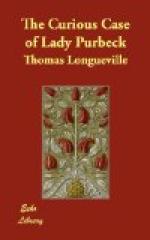“The ambassador for his purgation from this charge, went immediately to the Duke at Whitehall, but was denied accesse: Whereupon repairing to my Lord Chamberlain for his mediation, I was sent to him by his lordship, to let him know more particularly the Duke’s displeasure, and back by the ambassador to the Duke with his humble request but of one quarter of an hours audience for his disblaming. But the duke returning answer, that having always held him so much his friend and given him so many fair proofs of his respects, he took his proceeding so unkindly, as he was resolved not to speak with him. I reported this to the ambassador, and had for his only answer, what reason cannot do, time will. Yet, after this the Earls of Carliel and Holland interposing; the ambassador, (hungry after his peace from a person of such power, and regarding his masters service and the public affairs), he a seven night after obtained of the duke an interview in Whitehall garden, and after an hours parley, a reconciliation.”
As has just been seen, the officers of the law lost sight of Lady Purbeck. So also, for the present do we; but we know what became of her; for she was taken by Sir Robert Howard to his house at Clun, in the extreme south-west of Shropshire, where a small promontory of that county is bordered by Montgomeryshire, Radnorshire and Herefordshire. It is probable that, so long as she was far away from the Court and from London, Buckingham and the authorities took no trouble to find her or her paramour, and almost connived at their escape.
During their absence from our view, it may add to the interest of our story to observe the conditions at that time of some of the other characters who have figured in it, and to consider certain circumstances of the period at which we are halting. Looking back a little way, we shall find that King James, who we noticed was so ill as to be only just able to sign an order connected with the proceedings against Lady Purbeck, died in March, 1625, and that the very correct Charles I. was King during the subsequent proceedings.
Going further back still, we find that Bacon, who had succeeded in overthrowing Coke, was himself overthrown in 1621, three years after the marriage of Coke’s daughter to Sir John Villiers, and shortly after Bacon himself had been created Viscount St. Albans. Bacon was impeached on charges of official corruption, and his old enemy, Sir Edward Coke, who was then a member of Parliament, was to have had the pleasure of conducting the impeachment. Coke, however, was deprived of that gratification by Bacon’s plea of Guilty, and was obliged to content himself with attending the Speaker to the bar of the House of Lords when judgment was to be prayed, and with hearing the Chief Justice, by order of the Lords, condemn Bacon to a fine of L40,000, incapacity ever to hold any office again, exile from Court, and imprisonment in the Tower during the King’s pleasure.




